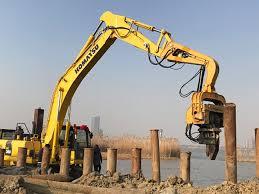Deep foundation construction is a critical part of many infrastructure projects, providing the necessary support for structures that must withstand heavy loads and challenging soil conditions. One of the most effective tools revolutionizing deep foundation work today is the excavator mounted vibratory hammer. This equipment combines the power and versatility of excavators with advanced vibratory hammer technology, resulting in a solution that significantly improves efficiency, safety, and precision in pile driving and extraction operations.
In this article, we explore how excavator mounted vibratory hammers enhance deep foundation work, their advantages over traditional methods, and key considerations for their use.
Understanding Excavator Mounted Vibratory Hammers
An excavator mounted vibratory hammer is a pile driving and extraction attachment designed to be mounted on a standard excavator boom. The vibratory hammer uses rapid vibrations to reduce soil resistance around piles, enabling easier and faster penetration or removal compared to impact hammers or static pressing.
These systems typically feature hydraulic motors that drive counter-rotating eccentric weights to create high-frequency vibrations. When connected to an excavator, they benefit from the machine’s mobility, power, and flexibility on job sites.
Advantages of Excavator Mounted Vibratory Hammers in Deep Foundation Work
1. Improved Efficiency and Speed
Traditional pile driving methods often rely on impact hammers that drive piles by repeated heavy blows. While effective, impact driving can be slower, especially in dense or cohesive soils. Excavator mounted vibratory hammers use continuous vibration to loosen soil around the pile shaft, dramatically reducing soil resistance and allowing piles to be installed or extracted more rapidly.
This efficiency can reduce project timelines, lower labor costs, and accelerate overall construction schedules, making vibratory hammers an attractive choice for contractors aiming to optimize productivity.
2. Versatility Across Various Pile Types
Excavator mounted vibratory hammers are suitable for a wide range of pile materials including steel sheet piles, H-piles, tubular piles, and precast concrete piles. The vibration method is gentle enough to avoid damaging piles, yet powerful enough to overcome soil friction.
This versatility enables contractors to use the same equipment for multiple foundation types, reducing the need for different specialized machinery on-site and simplifying logistics.
3. Reduced Noise and Vibration Impact
Compared to impact hammers, vibratory hammers produce significantly less noise and ground vibrations. This makes excavator mounted vibratory hammers ideal for projects located in urban or environmentally sensitive areas where noise pollution and vibration-induced damage to nearby structures must be minimized.
Lower noise levels improve working conditions for operators and surrounding communities, while controlled vibration limits soil disturbance and the risk of collateral damage.
4. Enhanced Operator Control and Safety
Mounted on an excavator, the vibratory hammer benefits from the machine’s hydraulic controls and advanced monitoring systems. Operators can precisely control the amplitude and frequency of vibrations to match soil conditions and pile types, optimizing driving or extraction without overloading equipment or risking pile damage.
Moreover, the excavator’s mobility allows operators to position the hammer quickly and safely, reducing manual labor and exposure to hazardous conditions.
5. Cost Savings on Equipment and Maintenance
Using excavator mounted vibratory hammers can reduce the need for multiple machines by consolidating pile driving and extraction capabilities into one versatile attachment. This can lead to cost savings on equipment rental or purchase, transportation, and maintenance.
The hydraulic vibratory components are generally durable and require less frequent repair compared to impact hammers, which endure significant mechanical stress during use.
Applications of Excavator Mounted Vibratory Hammers
- Pile Driving for Deep Foundations
These hammers are widely used in constructing deep foundations for bridges, buildings, and marine structures. Their ability to drive piles quickly and accurately helps ensure strong, stable foundations even in challenging soil conditions.
- Pile Extraction and Removal
Excavator mounted vibratory hammers also excel at extracting piles during demolition or foundation remediation. The vibration reduces soil friction around the pile, allowing easier removal without damaging the surrounding ground or adjacent structures.
- Sheet Pile Installation
Sheet piling is common in retaining walls, cofferdams, and flood defenses. Vibratory hammers enable fast installation of sheet piles with minimal noise and ground disturbance, crucial for sensitive environments.
Key Considerations When Using Excavator Mounted Vibratory Hammers
1. Excavator Compatibility
Ensure the vibratory hammer is compatible with the excavator’s weight class and hydraulic system. Overloading the machine can lead to equipment failure or safety hazards.
2. Soil and Site Conditions
While vibratory hammers are effective in many soil types, extremely dense or rocky soils may require supplemental impact driving or pre-drilling. Proper soil analysis prior to installation helps determine the best approach.
3. Pile Material and Dimensions
Select a vibratory hammer attachment that matches the size and type of piles to be driven. Incorrect sizing can cause inefficient driving or damage piles.
4. Operator Training
Operators should be trained on the specific vibratory hammer model and its controls to maximize efficiency and safety. Understanding vibration settings and soil response is essential.
5. Maintenance and Inspection
Regular inspection of hydraulic components, vibration mechanisms, and mounting points is critical to prevent downtime and ensure consistent performance.
Conclusion
Excavator mounted vibratory hammers represent a significant advancement in deep foundation construction, offering unmatched efficiency, versatility, and environmental benefits. Their ability to reduce installation times, minimize noise and vibration impact, and improve operator control makes them an indispensable tool for modern contractors.

